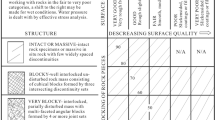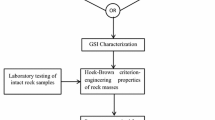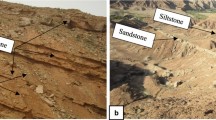Abstract
The paper suggests an alternative quantification of the Geological Strength Index (GSI) Chart published by Hoek et al. in Paper prepared for presentation at the 47th US Rock mechanics/geomechanics symposium held in San Francisco (2013). The engineering parameters proposed for the horizontal and vertical axes of the Chart are the most commonly used in routine field investigations on rock masses by means of standard exposure surveys and borehole logging. They mainly include parameters traditionally used for block size characterization (i.e., volumetric joint count Jv, joint spacing S and RQD/Jn factor) as well as other parameters purposely defined in the present study and based on combinations of the traditional ratings of the Bieniawski’s RMR89 classification. Adopting these options, new empirical equations for calculating the GSI have been fine tuned and tested on a real rock mass dataset. The comparison between the GSI values calculated using the new equations and those directly mapped during underground excavations has demonstrated the potentiality of the proposed methodology. The new quantification of the GSI Chart can be regarded as a useful and practical tool suitable to integrate the Hoek et al. (2013) approach. The complementary use of different and independent methods represents an effective practice to properly check and validate the final estimation of the GSI.









Similar content being viewed by others
References
Barton NR, Lien R, Lunde J (1974) Engineering classification of rock masses for the design of tunnel support. Rock Mech 6(4):189–239
Bieniawski ZT (1989) Engineering rock mass classification.Wiley, New York
Cai M, Kaiser PK (2006) Visualization of rock mass classification systems. Geotech Geol Eng 24(4):1089–1102
Cai M, Kaiser PK, Uno H, Tasaka Y, Minami M (2004) Estimation of rock mass deformation modulus and strength of jointed hard rock masses using the GSI system. Int J Rock Mech Min Sci 41:3–19
Carter TG, Marinos V (2014) Use of GSI for rock engineering design. In: Proceedings 1st international conference on applied empirical design methods in mining, Lima-Peru´, 9–11th June, 19
Carter TG, Diederichs MS, Carvalho JL (2008) Application of modified Hoek–Brown transition relationships for assessing strength and post yield behaviour at both ends of the rock competence scale. In: Proceedings the 6th international symposium on ground support in mining and civil engineering construction, 30 March–3 April 2008. Cape Town, South Africa, p. 37–59. J South Afr Inst Min Metall, 108:325–338
Cundall PA, Pierce ME, Mas Ivars D (2008) Quantifying the size effect of rock mass strength. SHIRMS 2008—Y. Potvin, J. Carter, A. Dyskin (eds), Australian Centre for Geomechanics, Perth, 3-15
Day JJ, Hutchinson DJ, Diederichs MS (2012) A critical look at geotechnical classification for rock strength estimation. 46th U.S. Rock mechanics geomechanics symposium, ARMA, Chicago
Deere DU (1963) Technical description of rock cores for engineering purposes. Felsmechanik und Ingenieurgeologie (Rock Mechanics and Engineering Geology), 1 (1):16–22
Dinc OS, Sonmez H, Tunusluoglu C, Kasapoglu KE (2011) A new general empirical approach for the prediction of rock mass strengths of soft to hard rock masses. Int J Rock Mech Min Sci 48:650–665
Hoek E, Kaiser PK, Bawden WF (1995) Support of underground excavations in hard rock. Balkema, Rotterdam, p 225
Hoek E, Marinos P, Benissi M (1998) Applicability of the geological strength index (GSI) classification for weak and sheared rockmasses. The case of the Athens Schist formation. Bull Eng Geol Env 57(2):151–160
Hoek E, Marinos P, Marinos V (2005) Characterisation and engineering properties of tectonically undisturbed but lithologically varied sedimentary rock masses. Int J Rock Mech Min Sci 42:277–285
Hoek E, Carter TG, Diederichs MS (2013) Quantification of the Geological Strength Index Chart. Paper prepared for presentation at the 47th US rock mechanics/geomechanics symposium held in San Francisco, June 23–26
Kim BH, Cai M, Kaiser PK, Yang HS (2007) Determination of block sizes of rock masses with non-persistent joints. Rock Mech Rock Eng 40(2):169–192
Li L, Ouellet S, Aubertin M (2009) An improved definition of rock quality designation, RQDc. ROCKENG09. In: Diederichs M, Grasselli G (eds) Proceedings of the 3rd CANUS rock mechanics symposium, Toronto, May 2009
Marinos P, Hoek E (2000) GSI: a geologically friendly tool for rock mass strength estimation. Proceedings of GeoEng 2000 at the international conference on geotechnical and geological engineering (Melbourne, Victoria, Australia). Technomic Publishers, Lancaster, pp 1422–1446
Marinos P, Hoek E (2001) Estimating the geotechnical properties of heterogeneous rock masses such as flysch. Bull Eng Geol Environ 60:82–92
Marinos P, Hoek E, Marinos V (2006) Variability of the engineering properties of rock masses quantified by the geological strength index: the case of ophiolites with special emphasis on tunnelling. Bull Eng Geol Environ 65:129–142
Marinos P, Marinos V, Hoek E (2007) Geological Strength Index (GSI) A characterization tool for assessing engineering properties for rock masses. In: Romana, Perucho, Olalla (eds.) Underground works under special conditions. Lisbon: Taylor and Francis: 13–21
Palmström A (1982) The volumetric joint count—A useful and simple measure of the degree of rock mass jointing. IAEG Congress, New Delhi., 221–228
Palmström A (1985) Application of the volumetric joint count as a measure of rock mass jointing. Int symp on Fundamentals of Rock Joints, Björkliden, pp 103–110
Palmström A (1986) The volumetric joint count as a measure of rock mass jointing. Invited lecture at the F3 (Fracture, Fragmentation and Flow) Conference, Jerusalem, 19 pp
Palmström A (1995) RMi—A rock mass characterization system for rock engineering purposes. PhD thesis, University of Oslo, Norway, pp. 400 http://www.rockmass.net
Palmström A (2005) Measurements of and correlations between block size and rock quality designation (RQD). Tunn Undergr Space Technol 20:362–377
Priest SD, Hudson JA (1976) Discontinuity spacings in rock. Int J Rock Mech Min Sci Geomech Abstr 13:135–148
Russo G (2009) A new rational method for calculating the GSI. Tunn Undergr Space Technol 24:103–111
Sonmez H, Ulusay R (1999) Modifications to the geological strength index (GSI) and their applicability to the stability of slopes. Int J Rock Mech Min Sci 36:743–760
Tzamos S, Sofianos AI (2007) A correlation of four rock mass classification systems through their fabric indices. Int J Rock Mech Min Sci 44(4):477–495
Author information
Authors and Affiliations
Corresponding author
Rights and permissions
About this article
Cite this article
Morelli, G.L. Alternative Quantification of the Geological Strength Index Chart for Jointed Rocks. Geotech Geol Eng 35, 2803–2816 (2017). https://doi.org/10.1007/s10706-017-0279-8
Received:
Accepted:
Published:
Issue Date:
DOI: https://doi.org/10.1007/s10706-017-0279-8




